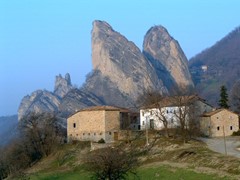Guiglia.
The Sassi di Rocca Malatina Regional Park and the Church of San Giovanni Battista
Nature lovers should not miss an outing to the Sassi di Rocca Malatina Regional Park. From the medieval village of Guiglia we ascend towards the area of the Parish Church of Trebbio, the entrance to the splendid natural reserve watched over by the striking “Sassi”: arenaceous spires up to 70 metres tall or over, and 40 million years old, dating back to a time when the sediments of the great Tethys Ocean that once covered the Tuscan-Emilian Apennines started to emerge.
Founded in 1988 to preserve a natural territory covering 2,300 hectares, the park stretches over a rolling hilly landscape that is easy to explore thanks to the numerous trails that wind amongst the woods and luxuriant glades filled with typical medium altitude vegetation.
A diversified micro-climate has led to the development of incredible biodiversity which ranges from plant species typical of the Mediterranean climate, such as helichrysum and tree heath, to others that are more typical of the mountains including blueberry bushes and beeches.
In the hush of nature it is not uncommon to come across some wild animals or spot some of the numerous ornithological species ‒ almost two hundred of them ‒ that inhabit the park.
It is possible to reach the top of the highest “sasso” thanks to a specially-equipped trail called “Salita al Sasso della Croce”, which leads up to a position offering a view of exceptional beauty. From south to west our gaze sweeps across the highest Apennine peaks, from Corno alle Scale, to the Cimone, to the set of pinnacles of Monte Cusna. On the clearest days the Alps and their foothills stand out clearly on the horizon.
But the park is not just nature: the villages and towers scattered through it are testimony of an ancient history that has been preserved. They once formed part of a vast defence system guarding the territory which, in the Middle Ages, towards the end of the 1200s, belonged to the Malatigni family involved in the ups and downs of the bloody struggle of conquest between Modena and Bologna. Only in 1406 did the fiefdom pass definitively to the Este family who brought to an end the Malatigni’s feudal career.
It is impossible to miss the small parish church of San Giovanni Battista, sitting on a hill sloping gently down to the eastern bank of the River Panaro, which runs through a stunning landscape dominated by the spires of the Sassi.
The first news we have of this church is from 1163 when it was mentioned in a document written at the castle, whose paltry remains are to be found on a nearby rise. Even though cited as a “parish church” from the second half of the XII century onwards, it is believed to have been built in an earlier age.
Its current appearance is due to restorations ‘in the style of’ carried out between 1897 and 1913. This involved a supplementary and at times arbitrary reconstruction of certain parts of the building, taking other medieval churches as a model. The numerous alterations affected the façade, the apses and the walls. Windows were opened along the sides and in the façade as well as a small door on the southern side with an archivolt recycled from a neighbouring house. Meanwhile the octagonal baptistery was built with stones from a demolished part of the façade. Many of the decorative elements were simply invented by the restorers inspired by pieces from the lapidary museum of the Modena Cathedral.
The only original parts are the architectonic structure with three naves, the crypt, the columns, their capitals, and the façade’s twin-lancet window and portal. Other restoration work damaged the capitals in the naves which feature relief work consisting of archaic motifs, geometric interweaving with finely-wrought vegetal elements. On the capital of the third semi-column on the right two knights face one another while a benedictory hand descends from above and a winged dragon at the bottom turns towards them; on the capital of the fourth semi-column on the left, unique of its kind in the River Po area, are depicted an unusual ribbon motif and original “drop” elements. Scholars believe that this decoration was inspired by models existing in Greek churches of the 11th century, given that these capitals are not to be found in any other medieval context.
The original interior sculptural decoration consists in just a few fragments incorporated in the concrete slabs of the presbytery fence, in the ambo, and in a baptismal basin ‒ now replaced by a copy ‒ found in fragments and put back together at the beginning of the 1900s, and placed inside the octagonal baptistery.
Certain scholars have hypothesised that the recomposed fragments of the presbytery and ambo, together with the remains of the baptismal basin, may date back to the 9th century, a period the earlier church belonged to, and on top of which the current church was built, presumably in 1108.
